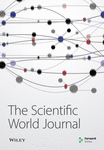Antioxidant Activity of Artocarpus heterophyllus Lam. (Jack Fruit) Leaf Extracts: Remarkable Attenuations of Hyperglycemia and Hyperlipidemia in Streptozotocin-Diabetic Rats
Abstract
The present study examines the antioxidative, hypoglycemic, and hypolipidemic activities of Artocarpus heterophyllus (jack fruit) leaf extracts (JFEs). The 70% ethanol (JFEE), n-butanol (JFBE), water (JFWE), chloroform (JFCE), and ethyl acetate (JFEAE) extracts were obtained. Both JFEE and JFBE markedly scavenge diphenylpicrylhydrazyl radical and chelate Fe+2in vitro. A compound was isolated from JFBE and identified using 1D and 2D 1H- and 13C-NMR. The administration of JFEE or JFBE to streptozotocin (STZ)-diabetic rats significantly reduced fasting blood glucose (FBG) from 200 to 56 and 79 mg%, respectively; elevated insulin from 10.8 to 19.5 and 15.1 μU/ml, respectively; decreased lipid peroxides from 7.3 to 5.4 and 5.91 nmol/ml, respectively; decreased %glycosylated hemoglobin A1C (%HbA1C) from 6.8 to 4.5 and 5.0%, respectively; and increased total protein content from 2.5 to 6.3 and 5.7 mg%, respectively. Triglycerides (TG), total cholesterol (TC), low-density lipoprotein cholesterol (LDL-C), VLDL-C, and LDL/HDL ratio significantly declined by -37, -19, -23, -37, and -39%, respectively, in the case of JFEE; and by -31, -14, -17, -31, and -25%, respectively, in the case of JFBE; as compared to diabetic rats. HDL-C increased by +37% (JFEE) and by +11% (JFBE). Both JFEE and JFBE have shown appreciable results in decreasing FBG, lipid peroxides, %HbA1C, TC, LDL-C, and TG levels, and increasing insulin, HDL-C, and protein content. The spectrometric analysis confirmed that the flavonoid isolated from JFBE was isoquercitrin. We can conclude from this study that JFEE and JFBE exert hypoglycemic and hypolipidemic effects in STZ-diabetic rats through an antioxidative pathway that might be referred to their flavonoid contents.




